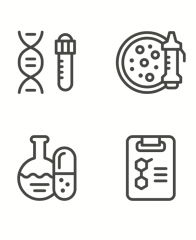 / How Informed Is Informed Consent?
Subscribe
/ How Informed Is Informed Consent?
Subscribe

Informed consent is one of the foundational requirements for conducting biomedical research on human subjects. But what exactly do we mean by “informed consent”? How do we know whether someone has given truly informed consent?
In the United States, there are federal regulations (known as the “Common Rule”) that spell out the requirements for what counts as adequate informed consent. These requirements include things like providing the patient or potential research subject (hereafter just “patient”) with a statement of the purposes and duration of the trial; a disclosure of the risks and possible benefits associated with the research procedures; and clarifying that the patient may withdraw from the trial at any time without penalty.
Note that the emphasis in these requirements is on information transfer. For the consent to be considered valid, the patient must be informed, demonstrate understanding, and then voluntarily agree to participate. One of the original justifications for this information-transfer model of consent was that it showed respect for the personhood of the patient, and would provide them with sufficient clarity about what they were getting into so that they could make an autonomous choice about whether participation was right for them.
But of course, research regulators and policymakers are aware that personhood and autonomy are both somewhat fraught philosophical notions. For example: We don’t let children consent. Are they not persons? What about patients with dementia? Can they make truly autonomous decisions? If not, then how can we ever ethically experiment on treatments for their condition?
To get around these thorny questions, the consent process is now more often cached out in terms of offering patients a reasonable choice. Because most clinical trials come with some risk and uncertainty, we want it to be sure that the decision to participate in the trial is a reasonable or rational one. This way we don’t need to work out who is a person or what exactly is autonomy. Instead, we can just make sure that the risks in a trial are disclosed during the consent process, and that signing the official consent form and participating in the trial is something that a reasonable or rational person could do.
However, I want to suggest that a further element—fairness—is also needed for a valid informed consent. For consent to be reasonable, I want to claim that it must be possible for the patient to know whether the conditions of their trial participation are fair.
The Ultimatum Game
In order to illustrate what I mean by a “fair offer,” and how that may differ from a reasonable offer, I want to digress briefly and discuss an experiment in economics called the “Ultimatum Game”. The game proceeds as follows: Player A is given a sum of money ($100, say) and must offer some division of that sum to player B. If player B accepts the proposed division, then the money is divided and each player receives the proposed amount. If player B rejects the proposal, then both players receive nothing.
According to rational decision theory, player A should offer player B the minimum possible value ($1, say) and player B should accept this offer because it is better than receiving nothing. In other words, it is reasonable both for player A to make this minimal offer and for player B to accept it. Yet, when this game is played by actual people in an experimental setting, A players will often offer B players close to a 50:50 split. B’s also tend to reject offers that seem unfair—that is, B’s generally choose to receive nothing (and punish A’s) rather than accept a minimal offer.
What accounts for these behaviors, given that they seem to deviate from the optimal strategies of rational decision theory? One explanation is that rejecting unfair offers (even when it would materially improve your own situation) is a social or evolutionary strategy, potentially hard-wired in our brains. Humans are social creatures and we all benefit from punishing those who would try to exploit us. A’s are (intuitively) aware of this, so they tend to offer fair splits; and B’s are ready to reject unfair offers and punish A’s even when it would be reasonable, in a strict sense, to accept them.
The Structure of Informed Consent
What can this game show us about the current requirements for informed consent? Let’s begin by observing the structural similarity: Study sponsors (e.g., drug companies) are player A. Sponsors plan and design the trial and then present the information about this plan in a summary package to patients, who are the players B. Patients do not get to propose modifications to the deal. They can either accept the offer presented to them and enroll in the trial or they can reject it and not enroll.
So far so good—and for clinical trials involving healthy volunteers, the decision to participate can look very much like player B’s decision in the Ultimatum Game. The sponsor is typically offering money (and sometimes free food and lodging too) in exchange for being allowed to experiment on the volunteer’s body. The volunteer must decide whether the compensation is reasonable given the risk, and can usually walk away from the offer if they deem it to be unreasonable or unfair.
But things get more interesting (and potentially problematic) when we start to examine how the stakes of this “game” play out for clinical trials of serious medical conditions. For the sponsors, the stakes are scientific and financial. They want an answer to a research question, like “does this drug benefit patients?” And if they can show that the drug is beneficial and receive regulatory approval, they may stand to make a great deal of money from its sale. However, for patients, the stakes are often much higher—or even existential. Patients considering trial participation will often have exhausted all other treatment options. Sometimes they cannot afford or access treatment in any other way but through research participation. This means that for subjects, the cost of rejecting an offer of trial participation may be quite high, perhaps even fatal.
Given this qualitative asymmetry in the gains and losses, we might worry that sponsors will be tempted to make unfair offers. In fact, as we learned from the Ultimatum Game, if sponsors want to maximize their own benefit, they absolutely should make unfair offers. They should offer patients the bare minimum, and it should still be considered reasonable (strictly speaking) for patients to accept this.
Observe also that in clinical trials, there is not just one player B and the sponsors do not receive “nothing” unless all or most patients reject the offer (i.e., the trial is cancelled or terminated because there are insufficient patients willing to enroll). This quantitative asymmetry of opportunity—the sponsor can offer the trial to many patients and only suffers negative consequences if too few accept—effectively strips the individual players B of what little power they might have had in the exchange. They cannot punish player A by rejecting an offer that seems unfair.
The Split for Trial Participants
Now let us ask: What kind of “split” are patients typically offered? The sponsor wants to test a new drug. If the new drug works, their plan is to make a great deal of money from its sale. What do they offer the research subjects in return?
Importantly, patients cannot be offered cures or even effective treatment—since the efficacy of the drug is precisely what the trial is testing. In fact, emphasizing this difference between research (where benefit cannot be assumed) and treatment (where benefit can be assumed) is another ethical cornerstone of human subject protections. Much effort is now devoted to dispelling the so-called “therapeutic misconception”—that is, the mistaken belief that a study is intended to benefit the research subjects. Sponsors must therefore insist that trials are research, designed to answer scientific questions, and the risks to patient-participants must be justified by the possibility of benefit to future patients.
But this means that the “split” offered to current patients is not an effective treatment for their condition. It is, at best, a chance at an effective treatment and the possibility of helping patients like them in the future. So translating this back to the terms of the Ultimatum Game, this would mean that player A does not have to propose anything definite. They can just propose that with some probability, player B might get something beneficial out of the deal (and future patients might benefit if the drug works).
Sound like a reasonable offer? A fair offer?
It gets worse. Sponsors are also not required to disclose how much they plan to charge for a new drug or treatment, should it be found to work and brought to market. And they never (as far as I’m aware) voluntarily disclose this information. So if sponsors do not have to share how much they expect to gain, this means that patients have no way of knowing whether or not they are getting a fair deal. Perhaps large sponsor profits seem to some patients like a fair trade for a chance at a life-saving treatment, but for this to even be a reasonable judgment that a patient could make, they would need to be provided with an estimate of those profits (and the corresponding cost to society).
Conclusion
So let’s put it all together. In this real-life version of the Ultimatum Game, which we call the “informed consent process,” there is a qualitative asymmetry between the losses if player B declines the offer; there are multiple B’s such that no individual player B can punish player A if they judge the offer to be unfair; player A does not have to disclose the total sum of money at stake (and consequently, does not provide B with enough information to judge whether the offer is fair or not); and player B can only ever be offered a chance at benefitting.
This sounds to me like a terribly unfair game, the terms of which no reasonable person could possibly accept. And the fact that many patients seek trial participation out of dire need, or are in any way desperate to accept such terms, makes the unfairness built into the structure of this exchange even more ethically problematic. This shows us that the research enterprise is currently structured to allow sponsors to leverage patient vulnerability for their financial gain.
But to be clear: The fact that the structure of the enterprise allows for this, does not entail that sponsors are regularly exploiting this advantage (although there are some recent questionable cases). Nevertheless, I think when we should be creating social, legal, and ethical mechanisms to empower patients, offset their vulnerability, and minimize the possibility of their exploitation.
We do have independent review of trial protocols and consent forms by ethics committees, who are entrusted with the social responsibility of ensuring that human subjects are protected. However, ethics committees are also not routinely told about the financial stakes (and sometimes they are not given adequate information about risks either), and therefore it is not clear that this mechanism is adequate to ensure a fair exchange.
Thus, I think we need to re-think our approach to informed consent and what is owed to patients who participate in clinical trials. So what might we do to make trial participation and the consent process not only more reasonable, but truly fair?
There are many steps we could take. We could pay research subjects more for participating. We could require legally binding contracts between subjects and sponsors to control the future price of the drug. But at a minimum, sponsors should be required to disclose the expected price of the new treatment, along with estimates for the cost of this new treatment to society (i.e., the annual cost to healthcare systems and private payers). Patients may still decide that they don’t care about this cost, and are willing to accept any offer for even the slimmest chance of a direct health benefit. But I don’t see how their consent can be considered reasonable and valid without this information. Without understanding what is at stake for the sponsor, they have no basis from which to judge whether the offer of trial participation is fair or exploitative.
Given that research subjects take on great risks and burdens for the benefit of future patients and society, I think we owe them a guarantee of a fair deal.
Acknowledgement: Without suggesting that they endorse or agree with any of the opinions expressed in this essay, the author would like to thank Holly Fernandez Lynch and Marc Tetel for helpful comments and feedback.
Dr. Hey is a teaching associate at the Harvard Center for Bioethics and a research scientist in the Program on Regulation, Therapeutics and Law (PORTAL) at the Brigham and Women’s Hospital in Boston, MA. He received his Ph.D. in philosophy from the University of Western Ontario. His work on ethics and human subjects research has been published in such venues as The BMJ, Science Translational Medicine, Journal of Medical Ethics, Hastings Center Report, STAT News, and Perspectives in Biology and Medicine.
Image Credit: Metamorworks, duo tone graphic of a woman showing a written informed consent. Shutterstock. Web. 14 May 2018.







